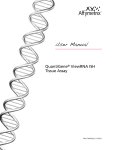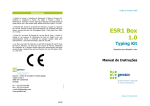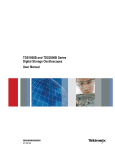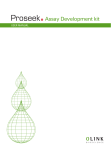Download 0656 v3.0 Duolink In Situ Brightfield User Manual
Transcript
User Manual – Brightfield The protocols in this manual are compatible with all Duolink In Situ PLA probes and Duolink In Situ Detection Reagents Brightfield (Art. no. 92012) Table of content 1. Introduction 4 2. Principle of the assay 5 3. Applications 3.1 Detect and quantify protein interactions 3.2 Detect and quantify protein modification 3.3 Detect and quantify protein expression 6 6 6 6 4. Reagents and equipment 4.1 Duolink II reagents 4.2 Reagents to be supplied by the user 4.3 Equipment needed 4.4 Duolink ImageTool – software for image analysis 7 7 8 8 8 5. Assay considerations 5.1 Choice of primary antibodies 5.2 Primary antibody optimization 5.3 Sample type 5.4 Pre-treatment 5.5 Staining and mounting 5.6 Controls 9 9 10 11 11 12 13 6. Reagent preparation 6.1 Duolink II reagents 6.2 Duolink II Wash Buffer 6.3 Samples 6.4 Reaction volume 14 14 15 15 15 7. Assay protocol 7.1 PLA probe protocol – CUSTOM solutions 7.2 PLA probe protocol – Duolink II Solutions 7.3 Proximity Ligation protocol 16 16 17 18 8. Results 8.1 Typical results 8.2 Image acquisition 8.3 Duolink ImageTool – Image analysis 20 20 21 22 9. Troubleshooting 23 Appendix A – Duolink II Wash Buffer formula Duolink II Wash Buffer A 26 26 References 27 Duolink In SItu Brightfield 3 1. Introduction Duolink® In Situ reagents from Olink® Bioscience enable detection, visualization and quantification of individual proteins, protein modifications and protein interactions in tissue and cell samples prepared for microscopy. The target is detected using one or two primary antibodies depending on the application. In the case that two primary antibodies are used, they must have been raised in different species. The Duolink In Situ reagents are based on in situ PLA®, which is a proximity ligation assay technology. A pair of oligonucleotide labeled secondary antibodies (PLA probes) generates a signal only when the two PLA probes have bound in close proximity, either to the same primary antibody or two primary antibodies that have bound to the sample in close proximity. The signal from each detected pair of PLA probes is visualized as an individual spot. These PLA signals can be quantified (counted) and assigned to a specific subcellular location based on microscopy images. 4 Duolink In Situ Brightfield 2. Principle of the assay Typical starting materials are adherent cells, cytospin preparations or tissue sections on a glass slide, fixed, pre-treated and blocked with a blocking reagent according to the requirements of the primary antibodies used. A. The samples are incubated with primary antibodies that bind to the protein(s) to be detected. A. B. Secondary antibodies conjugated with oligonucleotides (PLA probe MINUS and PLA probe PLUS) are added to the reaction and incubated. B. C. The Ligation solution, consisting of two oligonucleotides (illustrated as red bands) and Ligase, is added and the oligonucleotides will hybridize to the two PLA probes and join to a closed circle if they are in close proximity. C. D. The Amplification solution, consisting of nucleotides (not shown) is added together with Polymerase (yellow). The oligonucleotide arm of one of the PLA probes acts as a primer for a rolling-circle amplification (RCA) reaction using the ligated circle as a template, generating a concatemeric (repeated sequence) product extending from the oligonucleotide arm of the PLA probe. D. E. The Detection solution, consisting of horseradish peroxidase (HRP) labeled oligonucleotides, is added and the labeled oligonucleotides will hybridize to the RCA product. The signal is easily made visible as a distinct brown dot after enzymatic conversion of NovaRED substrate and analyzed by brightfield microscopy. E. Fig 1. Assay principle. Duolink In SItu Brightfield 5 3. Applications 3.1 Detect and quantify protein interactions Detection and quantification of interacting proteins can be done using two different primary antibodies against each of the two proteins of interest. Fig 2. Protein interactions 3.2 Detect and quantify protein modification Detection and quantification of a protein and its specific posttranslational modification can be done using two different primary antibodies, one directed against the target protein and one against a modification site on the same protein. Fig 3. Protein modifications 3.3 Detect and quantify protein expression Detection and quantification of protein expression can be done with two different approaches. (A) To detect and quantify one single protein with high sensitivity, use only one primary antibody. Fig 4. (A) Single recognition (B) To detect and quantify one single protein with high specificity, use two different primary antibodies directed against two different epitopes on the same protein. Fig 5. (B) Double recognition 6 Duolink In Situ Brightfield 4. Reagents and equipment 4.1 Duolink In Situ reagents The Duolink In Situ reagents are generic reagents using secondary antibodies for detecting presence of analyte-specific primary antibodies provided by the user. To run a Duolink In Situ Brightfield assay you need the following Duolink In Situ components. PLA probe MINUS PLA probe PLUS Detection Reagents Wash Buffer A Mounting Medium 4.1.1 Duolink In Situ PLA probes The choice of PLA probes depends on the species of your primary antibodies and your application, see section 3. For a complete list of PLA probes, visit www.olink.com Each Duolink In Situ PLA probe product contains the following: Blocking Solution – For blocking of the sample if you have not already optimized your primary antibody with another blocking solution. Supplied in ready-to-use concentration Antibody Diluent – For dilution of PLA probes and in some cases the primary antibodies (section 5.4.3). Supplied in ready-to-use concentration PLA probe (5x) stock – Secondary antibody conjugated with a PLA oligonucleotide 4.1.2 Duolink In Situ Detection Reagents Brightfield Each Duolink In Situ Detection Reagents Brightfield contains two boxes, A and B, together they contain the following: Ligation (5x) - Contains oligonucleotides that hybridize to the PLA probes and all components needed for ligation except the Ligase. Ligase (1 U/μl) Amplification (5x) – All components needed for Rolling Circle Amplification (RCA) except the Polymerase. Polymerase (10 U/μl) Detection Brightfield (5x) – HRP-labeled oligonucleotides. Hydrogen peroxide NovaRED substrate Nuclear stain (Mayers hematoxylin) Duolink In SItu Brightfield 7 4.1.3 Duolink In Situ Brightfield Mounting Medium A non-aqueous (xylene based) and permanent (hard set) mounting medium. 4.1.4 Duolink In Situ Wash Buffer A Duolink In Situ Wash Buffer A contains pouches to be dissolved in high purity water. 4.2 Reagents to be supplied by the user Reagents required for fixation and antigen retrieval of the sample (according to your own protocol, specific for each antigen and antibody used) Primary antibodies (matching a set of PLA probes) Ethanol and Xylene for rehydration and dehydration of the FFPE tissue samples High purity water (sterile filtered, MilliQ® or similar) Non-aqueous mounting medium 4.3 Equipment needed Brightfield microscope Staining jars Pen or mask for delimitation of reaction area (grease pen or silicon mask, e.g. ImmEdge™ Pen from Vector Laboratories) Shaker Humidity chamber (moist chamber) Freeze block for enzymes Incubator, +37°C Pipettes (covering the range from 1 µl to 1000 µl) Cover slips 4.4 Duolink ImageTool – software for image analysis The result from a Duolink In Situ experiment is typically a number of distinct spots, PLA signals, of sub-micrometer size in various locations of the studied cells. The Duolink ImageTool may be used to obtain objective quantification of PLA signals, however this software is primarily designed for counting PLA signals in images generated from fluorescence microscopy. The software automatically detects the nuclei and the cytoplasm size is estimated, enabling single cell statistical analysis of expression levels in tissue or cell populations. Furthermore, regions of interest can be defined, a feature of particular relevance when studying tissue samples. Raw imaging data can be imported directly from the four major microscope vendors (Olympus, Leica, Nikon and Zeiss). The results data can be exported into an Excel sheet for further evaluation. 8 Duolink In Situ Brightfield 5. Assay considerations 5.1 Choice of primary antibodies The Duolink In Situ reagents are generic reagents using secondary antibodies for detecting presence of analyte-specific primary antibodies. Your choice of primary antibodies is crucial when setting up the PLA assay. The primary antibodies should be of IgG-class, specific for the target to be detected and preferably affinity purified. The primary antibodies could be either polyclonal or monoclonal. To maximize your success rate, choose antibodies that are IHC and/or IF classified and follow the optimization guidelines given in section 5.2. Primary antibodies could also be qualified individually in a Duolink In Situ single recognition experiment (section 5.1.1 A) before a double recognition assay. 5.1.1 Primary antibodies for detection of protein expression When single protein targets are to be detected you can use either one or two primary antibodies against your target. A) One primary antibody (single recognition) Usage of one primary antibody gives you an easy to set up assay with high sensitivity. In this case only one antibody needs to bind the target under the conditions used (fixation, retrieval, buffer etc.). Using one primary antibody is only recommended for detection of single target proteins when a good performing specific primary antibody is available. If you use an unspecific antibody you will see high background due to the sensitivity of the assay. Using only one primary antibody is more efficient than using two primary antibodies when detecting low abundant targets. Fig 6. (A) Single recognition B) Two primary antibodies (double recognition) Usage of two primary antibodies will give you an assay with superior specificity. When using two primary antibodies, they must be directed against different, non-competing epitopes, on the same target molecule. The two primary antibodies must have been raised in different species. Also, both primary antibodies must bind to the target under the same conditions (fixation, retrieval, buffer etc.). Fig 7. (B) Double recognition Duolink In SItu Brightfield 9 5.1.2 Primary antibodies for detection of protein modifications Detection of protein modifications, such as phosphorylations, often suffers from low specificity. Our recommended strategy is to use two primary antibodies, one against the target protein and one against a modification site on the same protein. Preferably a specific modification site is targeted, but it is also possible to use a generic antibody against a modification site. Using two primary antibodies will give you superior specificity for your modification assay compared to using one single primary antibody. The two primary antibodies must be raised in different species. Also, both primary antibodies must bind to the target under the same conditions (fixation, retrieval, buffer etc.). Fig 8. Protein modifications 5.1.3 Primary antibodies for detection of protein interactions Duolink In Situ provides an excellent way to detect protein interactions and/or heterodimeric targets. This is done using two primary antibodies, each directed against one of the targets of interest. The two primary antibodies must be raised in different species and must bind to the target under the same conditions (fixation, retrieval, buffer etc.). Fig 9. Protein interactions 5.2 Primary antibody optimization You will save time and increase your success rate if you optimize your primary antibodies to be sure that they work properly in your material. The conditions for your primary antibodies should be optimized with respect to: Sample fixation Antigen retrieval Blocking solution Antibody diluent Primary antibody concentration Sample pre-treatment for Duolink In Situ is identical to procedures used for immunohistochemical (IHC) and/or immunofluorescence (IF) staining. If you already have a working assay for IHC or IF, use the same pre-treatment protocol. The primary antibody concentration may need to be titrated and optimized for the Duolink In Situ conditions. When using two primary antibodies, optimization is best done for one primary antibody at the time using the Duolink In Situ single recognition approach. These conditions can then be used as a start for optimizing your assays using both primary antibodies in the same Duolink In Situ assay. 10 Duolink In Situ Brightfield When using two primary antibodies it may in some cases be difficult to find conditions compatible with both of the selected primary antibodies. Under these circumstances it is advisable to search for other antibodies recognizing alternative epitopes. For further advice on immunostaining optimization we recommend the Education Guide from Dako (http://pri.dako.com/08002_25may06_ihc_guide_book.pdf). 5.3 Sample type Duolink In Situ Detection Reagents Brightfield performs well with Formalin Fixed Paraffin Embedded (FFPE) tissue sections. 5.4 Pre-treatment Before you start, make sure that your sample on the glass slide is sufficiently pre-treated with respect to fixation, retrieval and permeabilization. It is crucial for the performance of the assay to optimize the conditions for the primary antibodies. Also, the choice of wash buffer may be dependent on your primary antibodies. Use the recommendations from the vendor of your primary antibodies, if available. 5.4.1 Antigen/Epitope Retrieval Antigen/epitope retrieval is mostly used for FFPE material. Formalin fixation is masking the epitopes which then can be un-masked by antigen/epitope retrieval. Different methods for antigen/epitope retrieval will influence the performance of your primary antibodies and must be optimized for your application. Duolink In Situ is compatible with all antigen retrieval methods typically used for IHC including: Heat Induced Epitope Retrieval (HIER) Enzyme treatment with Proteinase K, Pepsin, Trypsin etc. For HIER it might be necessary to try a few different solutions of various pH. Free aldehydes that might cause unspecific binding of your primary antibodies to the sample after HIER can be quenched by washing the samples for 5 min in 2 µM glycine in PBS. 5.4.2 Quenching of endogenous peroxidase activity By incubating your tissue samples in hydrogen peroxide (H2O2), the possible endogenous peroxidase activity found in tissue will be suppressed. The time recommended in this protocol is optimized on tissues that are FFPE. Duolink In SItu Brightfield 11 5.4.3 Blocking solution and Antibody diluent It is essential to use a proper blocking solution and antibody diluent. Use the recommendations from the vendor of your primary antibodies, if available. If you have previously optimized your assay in for example IHC, use the same conditions for Duolink In Situ. There are two different protocols depending on whether you use your own blocking solution or the Duolink In Situ Blocking Solution. PLA probe protocol – CUSTOM solutions Use this protocol if you use your own blocking and antibody diluent (recommended), see section 7.1 The same agent used for blocking of the sample should be present also in the antibody diluent, preferably together with some detergent to reduce background staining, as well as in the diluent for the PLA probes. Note: Ensure that you do not use bulk IgG from the same species as your primary antibodies as blocking reagent as this will cause false signals from the PLA probes. PLA probe protocol – Duolink In Situ Solutions Use this protocol if you have no previous experience, or no recommendation from the antibody vendor, regarding blocking and antibody diluents, see section 7.2 Note: The Duolink In Situ Antibody Diluent contains salt, blocking agent and detergents. All to prevent unspecific binding of the antibodies. It is important that you first verify the function of your primary antibodies, one at the time, using Duolink In Situ single recognition or possibly IF or IHC. Use proper controls to verify that your individual antibodies do bind the correct target under the conditions used. 5.5 Staining and mounting 5.5.1 Developing The Detection Reagent contains an oligonucleotide labeled with horse radish peroxidase (HRP). Also included is the HRP substrate, NovaRED™, which together with HRP forms a visible enzyme substrate complex. This complex will appear as a red or red/brown product in a brightfield microscope. Developing time for NovaRED substrate in IHC is usually decided by the investigator, and varies between 5-15 min. The developing time appears to depend somewhat on the pretreatment of your sample. The enzyme based pretreatments produce dots of a larger size than the heat induced epitope retrieval does. Note: Slides developed with NovaRED should be dehydrated and mounted with a non-aqueous mounting media, e.g. Duolink In Situ Brightfield Mounting Media (Xylene based). 5.5.2 Nuclear staining Depending on how strong your HRP/NovaRED staining is, you can choose how strong the nuclear staining should be. However, if you intend to use image analysis we can recommend the nuclei to be well stained. After staining for 2 min in Duolink In Situ Nuclear stain, the specimen needs to be left in running tap water for about 10 min. This step is necessary to give the nuclear stain a chance to mature and to bring forth its specific blue color. Please note that you will achieve the best result with running tap water, not only to leave the slides in standing tap water. 12 Duolink In Situ Brightfield 5.5.3 Dehydration and clearing Dehydration is performed in steps of incubations in baths of increasing alcohol percentage, or possibly other dehydration liquids. Prior to the first bath, the slides are left in distilled, deionized or high purity water. Pass the slides through the alcohol gradient for three minutes in each bath (according to the User Manual), using two baths for each alcohol step. When transferred to your first clearing bath, let stand for 10 minutes before changing to the mounting bath. Duolink In Situ Detection Reagents Brightfield has been evaluated with alcohol as dehydration steps and xylene as clearing solution in combination with a xylene based mounting medium (Duolink In Situ Brightfield Mounting Medium, Art. no. 80102). 5.5.4 Mounting The specimen is developed with NovaRED substrate and should subsequently be dehydrated, cleared and then mounted with an organic mounting media. The red/brown staining product can darken with time, but this will not affect the staining quality. Please observe that you should not use an aqueous mounting medium. Duolink In Situ Detection Reagents Brightfield has been evaluated using Duolink In Situ Brightfield Mounting Medium, a xylene based mounting medium. Please work in a well ventilated area, e.g. fume hood, and let the slides dry well before analyzing in the microscope. 5.6 Controls To be able to properly evaluate your results it is advisable to include both biological and technical controls. Examples of suitable controls are given below. 5.6.1 Positive control Ideally you should include a cell or tissue type that you know contains your target protein and that your primary antibodies should bind to. If you are using two primary antibodies, the primary antibodies should be known to bind in close proximity. This also enables you to verify the Duolink In Situ procedure. 5.6.2 Negative control Ideally you should include a negative control with a cell line or tissue that does not express one or both of your targets. Such a control will give you information on the specificity of your primary antibodies. If this control gives you background signals in excess of signal obtained from omitting the primary antibody/antibodies, it means that your primary antibodies, under the present conditions, are binding to other targets than expected. If facing problems with signals in your negative cell line/tissue you might need to titrate your primary antibodies or look for more specific antibodies. 5.6.3 Negative control, technical By omitting primary antibodies you will get a hint of how the PLA probe background looks like in your system. Alternatively, if you are using an approach with two primary antibodies, you can also choose to omit only one of your primary antibodies. If facing problems with background signals with the primary antibodies omitted, consult the troubleshooting guide, see section 9. Duolink In SItu Brightfield 13 6. Reagent preparation 6.1 Duolink In Situ reagents Some Duolink In Situ reagents are supplied as concentrated stocks. Dilute required volumes of the stocks. Note: Do not store diluted reagents. Blocking Solution – store at +4°C Vortex before use Ready-to-use blocking solution, one drop equals approximately 40 μl Amplification (5x) – store at -20°C Antibody Diluent – store at +4°C Vortex before use For dilution of primary antibodies and PLA probes PLA probe (5x) – store at +4°C Vortex before use Dilute 1:5 in Antibody Diluent or custom diluent immediately before use and vortex the solution before addition to the sample Ligation (5x) – store at -20°C Thaw at room temperature and vortex before use Dilute 1:5 in high purity water immediately before use Note: The buffer contains DTT that may precipitate during freezing. Vortex to dissolve/ homogenize. Ligase (1 U/μl) – store at -20°C 14 The Ligase should be kept at -20°C at all times. Use a freezing block (-20°C) when removing the enzyme from the freezer Add the Ligase to the reaction mix at a 1:40 dilution immediately before addition to the sample Ensure that the Ligation-Ligase reaction solution is thoroughly vortexed before addition to the sample Duolink In Situ Brightfield Thaw at room temperature and vortex before use Dilute 1:5 in high purity water immediately before use Polymerase (10 U/μl) – store at -20°C The Polymerase should be kept at -20°C at all times. Use a freezing block when removing the enzyme from the freezer Add the Polymerase to the reaction mix at a 1:80 dilution immediately before addition to the samples Ensure that the AmplificationPolymerase reaction solution is thoroughly vortexed before addition to the sample Detection Brightfield (5x) – store at -20°C Thaw at room temperature and vortex before use Dilute 1:5 in high purity water immediately before use and vortex the solution before addition to the sample Substrate A-D – store at +4°C Thaw at room temperature and vortex before use Dilute in high purity water immediately before use and vortex the solution before addition to the sample Hydrogen peroxide – store at +4°C Drop bottle, ready for use Nuclear stain – store at +4°C Drop bottle, ready for use 6.2 Duolink In Situ Wash Buffer The washing steps should be performed in a staining jar, with a minimum volume of 70 ml, on a shaker (cradle) with gentle orbital shaking. Washing after the primary antibodies should be performed in Duolink In Situ Wash Buffer A or in the wash buffer optimal for your primary antibodies. In all subsequent wash steps ensure to use Duolink In Situ Wash Buffer according to protocol. Wash Buffer A – store at room temperature To prepare a 1x buffer, dissolve the content of one pouch in high purity water to a final volume of 1000 ml Store pouches at room temperature. 1x solutions may be kept at room temperature for short time storage (one week or less). For long time storage store at +4ºC. Bring the solutions to room temperature before use Alternatively make your own Duolink In Situ Wash Buffer A according to appendix A 6.3 Samples Before you start the Duolink In Situ protocol, make sure that your sample on the glass slide is sufficiently pre-treated with respect to fixation, retrieval and permeabilization, see section 5.2. Your reaction area must be delimited with e.g. a grease pen or silicon mask. 6.4 Reaction volume Use open droplet reactions Perform the incubations without a cover slip Perform all incubations in a pre-heated humidity chamber Use volumes corresponding to your delimited reaction area. Never use less than 15 μl of total reaction volume, see Table 1 or Reaction Volume Guide (Art. no. 80520) Note: It is important that all incubations are performed in a humid environment to prevent excessive evaporation. If the sample goes dry, this will give rise to severe artifacts. Table 1. Suitable reaction volume for different reaction areas. Area Total reaction volume 0.2 cm 15 μl 1 cm2 40 μl 2 2 cm2 80 μl 3 cm2 120 μl 4 cm2 160 μl 6 cm 240 μl 2 320 μl 8 cm2 10 cm 2 400 μl Duolink In SItu Brightfield 15 7. Assay protocol 7.1 PLA probe protocol – CUSTOM solutions Follow this protocol if you use your own blocking solution and antibody diluent that you know work with your primary antibodies. Before you start, your samples should be deposited on glass slides and pre-treated with respect to fixation, retrieval and/or permeabilization. Use open droplet reactions without a cover slip and perform all incubations in a humidity chamber. Use volumes corresponding to your delimited reaction area, see the Reaction Volume Guide (Art. no. 80520) or section 6.4. To avoid dilution of the reagents, tap off as much wash buffer as possible without letting the sample dry. 1 Peroxidase quenching a) Add the Hydrogen Peroxide solution to each sample. Note: Optimization of incubation time may be needed. b) Incubate at room temperature for 5 min. c) Wash the slides with 1x Wash Buffer A for 2 x 5 min under gentle agitation 2 Blocking Use your previously tested blocking solution. a) Add blocking solution to each sample. b) Incubate the slides. 3 Primary Antibodies Use your previously tested buffer to dilute your primary antibodies. a) Dilute your primary antibody to a suitable concentration in your custom antibody diluent. If using two primary antibodies dilute the two antibodies in the same diluent. b) Tap off the blocking solution from the slides. Try to obtain an equal residual volume on each slide as this will affect reproducibility. Do not allow the samples to dry before adding the primary antibodies as this will cause background. c) Add the primary antibody solution to each sample. d) Incubate in a humidity chamber. Use temperature and time optimal for your primary antibodies. 4 PLA probes Use the same buffer as for your primary antibodies or use Duolink In Situ Antibody Diluent. Note: The buffer should contain the blocking agent that was used for blocking the samples. a) Mix and dilute the two PLA probes 1:5 in your chosen buffer. Allow the mixture to sit for 20 min at room temperature. E.g. for a 40 μl reaction take 8 μl of PLA probe MINUS stock, 8 μl of PLA probe PLUS stock and 24 μl of the antibody buffer. b) Tap off the primary antibody solution from the slides. c) Wash the slides in a wash buffer suitable for your primary antibody. Washing should be performed in a staining jar, with a minimum volume of 70 ml on a shaker (cradle) with gentle orbital shaking. Bring the wash buffer to room temperature before use. d) Add the diluted PLA probe solution. e) Incubate the slides in a pre-heated humidity chamber for 1 h at +37°C. �� Proceed to the Detection protocol in section 7.3 on page 18. 16 Duolink In Situ Brightfield 7.2 PLA probe protocol – Duolink In Situ Solutions Follow this protocol if you use the Duolink In Situ Blocking Solution for blocking of your sample and Duolink In Situ Antibody Diluent for dilution of your primary antibodies. Before you start, your samples should be deposited on glass slides and pre-treated with respect to fixation, retrieval and/or permeabilization. Use open droplet reactions without a cover slip and perform all incubations in a humidity chamber. Use volumes corresponding to your delimited reaction area, see the Reaction Volume Guide (Art. no. 80520) or section 6.4. To avoid dilution of the reagents, tap off as much wash buffer as possible without letting the sample dry. 1 Peroxidase quenching a) Add the Hydrogen Peroxide solution to each sample. Note: Optimization of incubation time may be needed. b) Incubate at room temperature for 5 min. c) Wash the slides with 1x Wash Buffer A for 2 x 5 min under gentle agitation 2 Blocking a) Add one drop of Blocking Solution per 1 cm². Ensure to cover the entire reaction area with Blocking Solution. b) Incubate the slides in a pre-heated humidity chamber for 30 min at +37°C. 3 Primary antibodies a) Mix and dilute your primary antibody or antibodies to a suitable concentration in Antibody Diluent. b) Tap off the Blocking Solution from the slides. Try to obtain an equal residual volume on each slide as this will affect reproducibility. Do not allow the samples to dry before adding the primary antibodies as this will cause background. c) Add the primary antibody solution to each sample. d) Incubate in a humidity chamber. Use temperature and time optimal for your primary antibodies. 4 PLA probes a) Mix and dilute the two PLA probes 1:5 in Antibody Diluent. E.g. for a 40 µl reaction take 8 µl of PLA probe MINUS stock, 8 µl of PLA probe PLUS stock and 24 µl of Antibody Diluent. b) Tap off the primary antibody solution from the slides. c) Wash the slides in 1x Wash Buffer A or in a wash buffer suitable for your primary antibody, preferably 2 x 5 min. Washing should be performed in a staining jar, with a minimum volume of 70 ml on a shaker (cradle) with gentle orbital shaking. Bring the wash buffer to room temperature before use. d) Add the PLA probe solution. e) Incubate the slides in a pre-heated humidity chamber for 1 h at +37°C. �� Proceed to the Detection protocol in section 7.3 on page 18. Duolink In SItu Brightfield 17 7.3 Detection protocol Proceed from step 4e) of the PLA probe protocols. Use open droplet reactions without a cover slip and perform all incubations in a humidity chamber. The volume examples are based on 40 μl reaction volume, suitable for 1 cm2 reaction area. Adjust the volumes corresponding to your specific delimited reaction area, see the Reaction Volume Guide (Art. no. 80520) or section 6.4. 5 Ligation a) Dilute the Ligation stock 1:5 in high purity water and mix. Wait to add the Ligase until immediately before addition to the samples. Take the addition of Ligase into account when calculating the amount of water added. E.g. for a 40 μl reaction take 8 μl of the 5x Ligation stock and 31 μl of high purity water. b) Tap off the PLA probe solution from the slides. c) Wash the slides in 1x Wash Buffer A for 2 x 5 min under gentle agitation. d) Add Ligase to the Ligation solution from step a) at a 1:40 dilution and vortex. E.g. for a 40 µl reaction add 1µl of Ligase to 39 µl of Ligation solution. e) Add the Ligation-Ligase solution to each sample. f) Incubate the slides in a pre-heated humidity chamber for 30 min at +37°C. 6 Amplification a) Dilute the Duolink In Situ Amplification stock 1:5 in high purity water and mix. Wait to add the Polymerase until immediately before addition to the sample. Take the addition of Polymerase into account when calculating the amount of water added. E.g. for a 40 µl reaction take 8 µl of the 5x Amplification stock and 31.5 µl of high purity water. b) Tap off the Ligation-Ligase solution from the slides. c) Wash the slides in 1x Wash Buffer A for 2 x 2 min under gentle agitation. Tap off all wash solution after the last washing. d) Add Duolink In Situ Polymerase to the Amplification solution from step a) at a 1:80 dilution and vortex. E.g. for a 40 µl reaction add 0.5 µl of Polymerase to 39.5 µl of Amplification solution. e) Add the Amplification-Polymerase solution to each sample. f) Incubate the slides in a pre-heated humidity chamber for 90 min or 120 min at +37°C. Note: The amplification time is dependent on the epitope retrieval process in your pre-treatment protocol. Heat Induced Epitope Retrieved (HIER) slides should be amplified for 120 min and Enzyme Induced Epitope Retrieved (EIER) slides for 90 min. 18 Duolink In Situ Brightfield 7 HRP labeled probes a) Dilute the Detection Brightfield stock 1:5 in high purity water and mix. E.g. for a 40 µl reaction take 8 µl of the 5x Detection stock and 32 µl of high purity water. b) Tap off the Amplification-Polymerase solution from the slides. c) Wash the slides in 1x Wash Buffer A for 2 x 2 min under gentle agitation. d) Add the Detection Brightfield solution to each sample. e) Incubate the slides in a humidity chamber for 60 min at room temperature. 8 Substrate solution a) Dilute the Substrate, A (1:70), B (1:100), C (1:100) and D (1:50) reagents in high purity water. E.g. for a 40 µl reaction add 0.6 µl Substrate A, 0.4 µl Substrate B, 0.4 µl Substrate C, 0.8 µl Substrate D in 37.8 µl high purity water. b) Tap off the Detection Brightfield solution from the slides. c) Wash the slides in 1x Wash Buffer A for 2 x 5 min under gentle agitation. d) Add the Substrate solution to each sample. e) Incubate the slides for 5 to 10 min at room temperature. 9 Nuclear stain a) Wash the slides in high purity water for 2 x 2 min under gentle agitation. b) Add the Nuclear Stain to each sample, one drop equals 40 µl. Note: The Nuclear Stain is supplied in working concentration, no dilution is required. c) Incubate the slides for 2 min at room temperature. d) Wash the slides under running tap water for 10 min. 10 Dehydration a) 96% EtOH for 2 x 2 min b) 99.7% EtOH for 2 x 2 min c) Xylene for 10 min d) Move slide to fresh Xylene 11 Preparation for imaging Use a minimal volume of non-aqueous mounting medium (e.g. Duolink In Situ Brightfield Mounting Medium) and apply a cover slip on top of your sample. Preferably add the mounting medium to the cover slip and then gently slip over the sample slide to ensure no air bubbles get caught under the cover slip. Work in a well ventilated area, e.g. fume hood, and let the slides dry well before analyzing in a brightfield microscope, using at least a 20x objective. Duolink In SItu Brightfield 19 8. Results 8.1 Typical results The result from using Duolink In Situ Detection Reagents Brightfield is typically a number of distinct red/brown spots (PLA signals) in the tissue, see Figure 10. In some cases, when studying highly expressed proteins, the density of signals may be so high that the signals coalesce, see Figure 11. A B Fig 10. Detection of HER2/HER3 heterodimers in FFPE breast cancer tissue using Duolink In Situ with two primary antibodies, where the primary antibodies have been titrated to the optimal concentration to give individual signals. PLA signals are shown in red/brown and the nuclei in blue. A) Positive sample. B) Negative control (no primary antibodies). A B Fig 11. Detection of the HER2 receptor in FFPE breast cancer tissue (scored as 2+ with regard to HER2 with IHC by Pantomics Inc.) using Duolink In Situ with one primary antibody where the primary antibody needs to be titrated to give individual signals. PLA signals are shown in red/brown and the nuclei in blue. A) Positive sample. B) Negative control (no primary antibody). 20 Duolink In Situ Brightfield 8.2 Image acquisition The PLA signal detected with Duolink In Situ Detection Reagents Brightfield is recognized as a red/brown spot, see Figure 10, in a brightfield microscope. Brightfield microscopy images are usually taken in one focal plane. An individual PLA signal is sub-micrometer in size and can therefore be above or below the current focus. To reduce the number of PLA signals that are out of focus, use an objective with high numerical aperture. A true PLA signal can be “scanned through” by changing the focus making it appear and disappear. This does not apply to coalesced signals which may occur for highly expressed proteins, see Figure 11. To detect all signals it might be necessary to obtain images throughout the entire thickness of the sample. However, you may acquire images in one plane as long as all images to be compared are acquired in a similar position within the sample. As with all images that are to be analysed, visually or by software, it is important to keep all settings constant during an experiment with regards to light intensity, exposure time and grey filters used etc. The light intensity in combination with the exposure time should be set to give the correct over/under exposure balance. Other functions that can influence an analysis are to use the right shading correcting and to do a white balance. Duolink In SItu Brightfield 21 8.3 Duolink ImageTool – Image analysis To analyze the results, you may use Duolink ImageTool to obtain objective quantification of PLA signals. However this software is primarily designed for counting PLA signals in images generated from fluorescence microscopy. By using the software it is possible to obtain either the number of signals and cells per image, allowing average measurements, or to allocate each individual signal to a specific cell using single cell analysis. The nuclei are automatically detected and cytoplasm size estimated, enabling single cell statistical analysis of expression levels in tissue or cell populations. A result can typically look as shown in Figure 12. Fig 12. Analysis of an image from a brightfield microscope. Nuclei are blue, the red/brown spots are the PLA signals representing the protein target of interest. In the analysis, PLA signals marked with red circles and nuclei outlined in yellow are quantified at analysis. The green outlines represent the user defined cytoplasm size. When studying highly expressed proteins the density of PLA signals may be so high that it is impossible to discriminate between individual signals, see Figure 11. Duolink ImageTool can not quantify regions of merged signals; only separable signals can be counted. In this case the data is best analyzed by intensity measurement of the area fraction of the sample with signal, using software for traditional image analysis. The primary antibodies used in the assay can be titered down to reduce the number and incidence of merged signals. 22 Duolink In Situ Brightfield 9. Troubleshooting Some general guidelines are given below. Problem Probable cause Suggested solution No or few signals in positive samples No or insufficient binding of primary antibodies Check primary antibodies in an ordinary IHC, or IF, against a positive control in relevant samples with similar fixation, retrieval protocol, blocking and buffer conditions as used for PLA. Evaluate and optimize fixative, retrieval, incubation temperature, time, concentration and buffer composition. Insufficient reaction volume Ensure that your reaction area corresponds to the reaction volume. The droplet must cover the reaction area. Encircle your reaction area using a hydrophobic barrier and incubate the slides in a humidity chamber to prevent evaporation. Do NOT use a cover slip to disperse the droplet. No amplification Ensure that the Polymerase has been stored at -20°C. Check that the incubator is not warmer than 37°C. Inefficient ligation Keep ligation incubation time and temperature. Ensure that no excessive amount of wash solution remain on slide before addition of ligation reagents. Ensure that the Ligase is active (i.e. has been kept at -20°C) and that correct dilution of the reagents have been used. Prepare fresh dilutions just before use; do not allow mix, with enzyme, to stand for more than 5 minutes before use. Inefficient amplification If the signals are very weak they can appear to be few, as only a fraction reaches above detection threshold. Ensure that no excessive amount of wash solution remains on the slide before addition of amplification reagents. Keep amplification time and temperature. Ensure Polymerase is active (i.e. has been kept at -20°C) and that correct dilution of the reagents have been used. Prepare fresh dilutions just before use; do not allow mix, with enzyme, to stand for more than 5 minutes before use. Inefficient detection If the signals are weak they can appear to be few, as only a fraction reaches above detection threshold. Ensure that the Detection stock or solution has not been exposed to excessive heating or extended time of light during handling or incubation. Ensure that the reagents were correctly diluted. Duolink In SItu Brightfield 23 24 Problem Probable cause Suggested solution Large variation of signals over slide (individual reaction) Uneven spread of reagents during different steps Ensure that entire area of investigation is covered during each step. Partial drying of parts of the area during incubation Check before each new step that no region has dried during incubation. If so, use a better humidity chamber. High background – general cause Incomplete deparaffinization If you use paraffin embedded samples, incomplete removal of paraffin can cause background. Use fresh solutions if necessary and ensure correct times during deparaffinization. Custom blocking solution If you have used your own blocking solution, allow primary antibody and PLA probes to be in contact with your blocking reagent before addition to the sample. Dilute the PLA-probes with your own diluent (the same as you used for blocking) and let this incubate in RT for 20 min before applying it to the slides. Not sufficient washing of slides Ensure sufficient washing and use fresh wash solutions and clean jars. Drying of sample Ensure good humidity during all incubation steps and never let slides dry out after washes and before addition of reagents. Unspecific binding of primary antibodies Titrate primary antibodies (IHC or PLA) with respect to concentration, temperature, time and buffer and ensure appropriate fixation protocol was used. Unspecific binding of secondary reagents Avoid drying of samples during incubation and extended incubation times at high concentration of PLA probes. If you want to use serum as an antibody diluent it is possible to use normal donkey serum together with the anti-species PLA probes. PLA-probes directed against species are all raised in donkey. Brown signals or shading in your negative control Not sufficient H2O2 quenching Endogenous peroxidase is still active in the specimen and will thus develop the substrate. Too long developing time If the developing will proceed for too long, the background will increase as a brown shadow over the staining area. The reaction spreads over a too large surface/ is unable to cover sample No or insufficient delimitation around reaction area Use a grease-pen or alike to encircle reaction area. Inappropriate reaction volume Adjust reaction volume according to your reaction area. For guidance on reaction volumes please refer to section “Reagent Preparation” or the separate Reaction Volume Guide. Duolink In Situ Brightfield Problem Probable cause Suggested solution No nuclear staining or red nuclear staining is observed No addition of Mayers Hematoxylin Ensure that the Mayers Hematoxylin will be added and that it is prediluted and ready to use. No maturation of Hematoxylin The maturation should be allowed for 10 min in running tap water. It will not work as well to use cleaner water for this step. Difficulties in focusing signals in specimen Sections of tissue are too thick Try to use sections that are 4 µm or thinner. The size of the Duolink In Situ HRP-signals are 0.3 – 0.5 µm in diameter. It is a challenge to get the focus plane containing most of the signals, but it will be easier when the section is thin. If problems remain, please contact us at [email protected] or +46 18 444 3970 Duolink In SItu Brightfield 25 Appendix A – Duolink In Situ Wash Buffer formula Duolink In Situ Wash Buffer A Alternative 1 – use Duolink In Situ Wash Buffer A pouches To prepare a 1x buffer, dissolve the content of one pouch in high purity water to a final volume of 1000 ml. Store pouches at room temperature. Expiry date is marked on each individual lot. 1x solutions may be kept at room temperature for short time storage (one week or less). For long time storage store at +4ºC. Bring the solutions to room temperature before use. Alternative 2 – make your own Duolink In Situ Wash Buffer A Dissolve 8.8 g NaCl, 1.2 g Tris base and 0.5 ml Tween 20 in 800 ml high purity water. Adjust pH to 7.4 using HCl. Add high purity water to 1000 ml (final concentrations 0.01 M Tris, 0.15 M NaCl and 0.05% Tween 20). Filter the solution through a 0.22 μm filter and store at +4°C. Bring the solutions to room temperature before use. 26 Duolink In Situ Brightfield References Jarvius M, Paulsson J, Weibrecht I, Leuchowius KJ, Andersson AC, Wählby C, Gullberg M, Botling J, Sjöblom T, Markova B, Östman A, Landegren U, Söderberg O. In situ detection of phosphorylated plateletderived growth factor receptor β using a generalized proximity ligation method. Molecular and Cellular Proteomics, 6, 1500-1509 (2007). Söderberg O, Gullberg M, Jarvius M , Ridderstråle K, Leuchowius KJ, Jarvius J, Wester K, Hydbring P, Bahram F, Larsson LG, and Landegren U. Direct observation of individual endogenous protein complexes in situ by proximity ligation. Nat Methods, 3, 995-1000 (2006). Gullberg M, Gustafsdottir SM, Schallmeiner E, Jarvius J, Bjarnegård M, Betsholtz C, Landegren U, and Fredriksson S. Cytokine detection by antibody-based proximity ligation. Proc Natl Acad Sci USA, 101, 8420‑24 (2004). Fredriksson S, Gullberg M, Jarvius J, Olsson C, Pietras K, Gustafsdottir SM, Östman A, and Landegren U. Protein detection using proximity-dependent DNA ligation assays. Nat Biotechnol, 20, 473-77 (2002). Duolink In SItu Brightfield 27 This product is for research use only. Not for use in human diagnostic or therapeutic procedures. This product includes a license for non-commercial use of the Duolink product. Commercial users will require additional licenses. Please contact Olink AB for details. There are no warranties, expressed or implied, which extend beyond this description. Olink AB is not liable for property damage, personal injury, or economic loss caused by this product. NovaRED™ is a trademark of Vector Laboratories, Burlingame, USA. This product is covered by several patents and patent applications including US 6,511,809, US 6,558,928, US 6,8785,15, US 7,074,564, US 5,665,539 and related US and foreign patents. For use only as licensed by Amersham Biosciences Corp (part of GE Healthcare Bio-Sciences) and Molecular Staging Inc. The Phi 29 DNA polymerase may not be re-sold or used except in conjunction with the other components of this product. See U.S. Patent Nos. 5,854,033, 6,124,120, 6,143,495, 5,001,050, 5,198,543, 5,576,204, and related U.S. and foreign patents. © 2012 Olink AB. All third party trademarks are the property of their respective owners. Olink Bioscience Dag Hammarskjölds v. 52B SE-752 37 Uppsala, Sweden www.olink.com 0656, v. 3.0, 2012-03-12 The following trademarks are owned by Olink AB: Olink®, Olink Bioscience, Duolink® and PLA®.






































